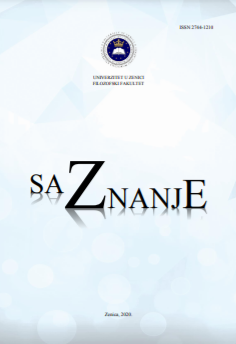VRŠNJAČKO NASILJE MEĐU DJECOM SA FOKUSOM NA RODNO ZASNOVANO NASILJE
PEER VIOLENCE AMONG CHILDREN WITH A FOCUS ON GENDER-BASED VIOLENCE
Author(s): Šejla Bjelopoljak, Vildana Pečenković, Arijana MidžićSubject(s): Gender Studies, Education, School education, Studies in violence and power
Published by: Filozofski fakultet, Univerzitet u Zenici
Keywords: types of violence; students; educational measures; role of teachers;
Summary/Abstract: The emergent forms of peer and gender based violence argue for the need for intentional educational action. The presence of violence in schools poses a great challenge for society to adequately respond to the consequences of peer violence, which have also characterized the contemporary development of society. A mindset that allows for the creation of conditions in which each individual feels accepted and safe involves the internalization of inclusive principles, especially when it comes to institutional upbringing. In relation to the context of understanding a safe environment, in this research paper we have given particular importance to the composition of the target group in an institutional setting with a focus on general information on understanding violence and educational styles that implicate gender inequality. Given that there is research on the incidence of peer violence in relation to the characteristics of children who are exposed to violence, children who are perpetrators of violence, who are experiencing violence themselves, this paper has operationalized the definition of violence from the perspective of the research sample. The reason for this operationalization is to belong to different groups in the sense of: committing violence - actively committing violence, suffering violence - the tacit majority and activists who report and suppress manifestations of violence. Peer violence has been catching the attention of researchers for years, resulting in numerous studies examining the contributing factors to the occurrence of peer, genderbased violence, and we have chosen to examine the occurrence of peer violence, exposure to peer violence, and propensity for violent behavior in a sample of 10 to 14 years old children in primary schools, and the representation of forms of violence and disciplinary action by a professional team from each school implementing prevention measures under the revised „Protocol on the Treatment of Violence involving Children”. Research activities included examining the frequency of behaviors that occur in violent interactions, students' exposure to peer violence, which includes indicators of suffering from peer violence and victim role behavior, then a tendency to commit violent behavior, related to the manifestation of physical and psychological violence. Questionnaires for school professionals applying the „Protocol on the Treatment of Violence Including Children“ and the Questionnaire for Peer Violence Assessment - PRONA will collect data regarding the representation of forms of violence (recognized by the Protocol on Violence Treatment) and educational disciplines measures implemented in response to socially unacceptable behavior.
Journal: saZnanje
- Issue Year: 2/2020
- Issue No: 2
- Page Range: 591-607
- Page Count: 17
- Language: Croatian

